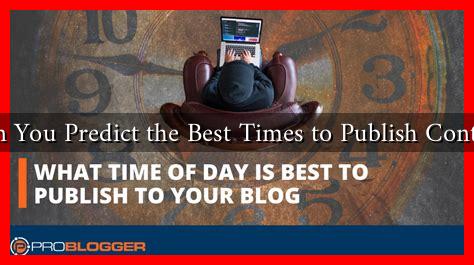-
Table of Contents
Can You Predict the Best Times to Publish Content?
In the digital age, content is king. However, even the most well-crafted articles, videos, or social media posts can fall flat if they are not published at the right time. Understanding when to share your content can significantly impact its reach and engagement. But can you predict the best times to publish? This article delves into the factors that influence optimal publishing times and offers strategies to help you make informed decisions.
The Importance of Timing in Content Publishing
Timing is crucial in content marketing for several reasons:
- Audience Availability: Your target audience may only be active during specific times of the day or week.
- Algorithm Preferences: Social media platforms often prioritize content based on engagement metrics, which can be influenced by when you post.
- Competition: Publishing during peak times can mean more competition for attention, while off-peak times may offer a better chance to stand out.
Factors Influencing Optimal Publishing Times
Several factors can help you predict the best times to publish content:
- Audience Demographics: Understanding your audience’s age, location, and lifestyle can provide insights into their online behavior.
- Platform-Specific Trends: Different social media platforms have unique peak times. For instance, studies show that Facebook engagement peaks on Wednesdays at 11 a.m. and 1 p.m.
- Industry Standards: Certain industries may have established norms for when content is most effective. For example, B2B companies often see higher engagement during weekdays, while B2C brands may perform better on weekends.
Utilizing Data and Analytics
One of the most effective ways to predict the best times to publish is by leveraging data and analytics. Here are some strategies:
- Google Analytics: Use Google Analytics to track when your audience is most active on your website. Look for patterns in traffic spikes and engagement metrics.
- Social Media Insights: Platforms like Facebook, Instagram, and Twitter provide insights into when your followers are online. Use this data to inform your posting schedule.
- A/B Testing: Experiment with posting at different times and analyze the results. This can help you identify the most effective times for your specific audience.
Case Studies and Examples
Several brands have successfully utilized data to optimize their content publishing times:
- Buffer: Buffer conducted a study analyzing over 4 million tweets and found that the best time to tweet is between 12 p.m. and 1 p.m. on weekdays.
- CoSchedule: CoSchedule’s research indicates that the best time to post on Facebook is between 1 p.m. and 3 p.m. on weekdays, while Instagram sees higher engagement on Mondays and Thursdays.
These examples highlight the importance of data-driven decision-making in content publishing. By analyzing trends and audience behavior, brands can significantly enhance their reach and engagement.
Conclusion: Making Informed Publishing Decisions
While predicting the best times to publish content may not be an exact science, leveraging data, understanding your audience, and analyzing industry trends can provide valuable insights. By considering factors such as audience demographics, platform-specific trends, and industry standards, you can make informed decisions that enhance your content’s visibility and engagement.
In summary, the key takeaways are:
- Timing is crucial for maximizing content reach and engagement.
- Utilize analytics tools to track audience behavior and engagement patterns.
- Experiment with different posting times to find what works best for your audience.
By implementing these strategies, you can significantly improve your content marketing efforts and ensure that your valuable content reaches its intended audience at the right time.
For more insights on content marketing strategies, check out HubSpot’s guide on content marketing.

